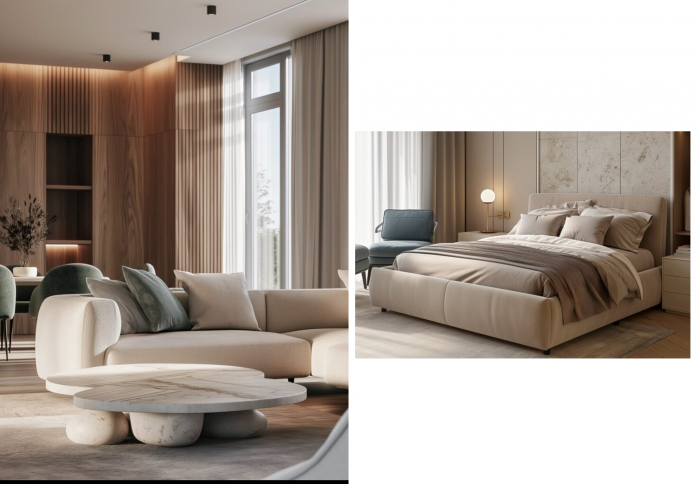Contemporary interior design has emerged as one of the most dynamic and enduring styles in the modern home landscape. More than just a trend, it is a philosophy rooted in simplicity, function, and adaptability. Unlike traditional styles locked into a historical mold, contemporary design responds to the present—reflecting evolving technologies, social shifts, and the changing rhythms of everyday life. In this feature, we explore the evolution, defining features, latest trends, and practical applications of contemporary interior design style, revealing why it remains at the forefront of modern living.
A design style defined by evolution
Contemporary interior design is not a static genre—it is a moving target. It shifts with the times, incorporating new materials, forms, and technologies while staying true to its core values of clarity, openness, and utility. Rooted in the modernist principles of the 20th century, it builds upon that legacy with a deeper sensitivity to space and the human experience.
From the post-war minimalism of the 1950s to the bold geometries of the 1980s, contemporary design has continuously evolved. Today’s expressions include serene, clutter-free environments balanced with bold artwork, smart home integrations, and an emphasis on natural light. In urban lofts, industrial materials mix with minimalist furniture; in coastal homes, open plans and eco-friendly surfaces bring the outdoors inside. It’s this elasticity—this ability to adapt without losing identity—that defines the contemporary style. As our needs and technologies change, so does the way we live. And contemporary design, by nature, lives and grows with us.
Core characteristics of contemporary interiors

Though ever-evolving, contemporary interiors are identifiable by a handful of defining features. These include open layouts, clean architectural lines, a neutral palette punctuated with occasional bold accents, and a blend of functionality with visual restraint.
Spatial openness is central: contemporary homes avoid walls where possible, favoring seamless transitions between living, dining, and kitchen areas. Light is maximized through expansive windows and minimal window treatments, while ceilings are often high to enhance volume and airiness.
Minimalism, however, is not about sterility. It’s intentional—every element is carefully chosen for both purpose and form. Furniture is sleek and low-profile, with hidden storage and multi-use capabilities. Materials often include polished concrete, glass, natural woods, and metal, adding visual depth through texture rather than ornamentation. Neutral tones—whites, soft grays, taupes—dominate the palette, but are frequently accented by statement pieces or bursts of saturated color.
Finally, technology is not simply added; it is embedded. From smart lighting and hidden speakers to touch-activated cabinetry, technology complements the design without calling attention to itself.
Contemporary design’s impact on modern homes

The influence of contemporary design can be seen in every corner of the modern home. Kitchens are transformed into open, social hubs. Bathrooms evolve into spa-like escapes. Bedrooms prioritize rest and clarity, often with uncluttered walls, muted tones, and soft textures.
Architecturally, the aesthetic has shaped the very bones of today’s homes—flat roofs, clean facades, and expansive glass panes that erase boundaries between interior and exterior. Inside, functional elegance reigns. Floating vanities, frameless cabinetry, and minimalistic fireplaces emphasize sophistication without fuss.
Function and beauty go hand in hand. In the contemporary home, there is no room for “just decor.” Every piece, from lighting to furniture, must enhance usability while supporting the overall aesthetic.
Trends shaping contemporary interiors

While the style itself is adaptive, several trends currently define its most current interpretations:
- Natural and sustainable materials: A growing desire for environmental responsibility has brought bamboo flooring, recycled glass, and reclaimed wood into the contemporary palette.
- Earthy color palettes: While neutral tones still dominate, they are increasingly joined by nature-inspired shades like terracotta, sage, and deep ocean blue.
- Flexible furniture: Modular sofas, nesting tables, and extendable surfaces allow rooms to adapt to changing uses and smaller living areas.
- Textural contrast: Matte finishes, tactile wall coverings, and raw textiles replace gloss, offering a more grounded and sophisticated feel.
- Statement lighting: Sculptural fixtures and geometric forms double as functional elements and art installations.
- Biophilic design: Indoor plants, natural materials, and organic shapes reflect a renewed interest in connecting with nature.
These trends reflect a wider cultural movement toward wellness, sustainability, and personalization—all values that pair seamlessly with the contemporary approach.
Simplicity as a lifestyle

At its heart, contemporary interior design embraces simplicity, but not at the expense of personality. Minimalism here is purposeful, not cold. Rooms breathe, visual noise is reduced, and each element contributes to the whole.
This approach creates more than just aesthetically pleasing environments; it fosters mental clarity and calm. In an age where overstimulation is the norm, the contemporary home offers refuge—a space where everything has a role and nothing feels excessive.
Yet, contrast and individuality remain welcome. A bold canvas on a white wall, a sculptural chair in an otherwise restrained space, or a single burst of color in an otherwise monochromatic room—all speak volumes without overwhelming.
Technology meets design
Perhaps the most distinctive feature of today’s contemporary interior design is the seamless integration of smart technology. Homes now include lighting systems that adapt to time of day, voice-controlled appliances, and invisible speakers built into ceilings.
This isn’t technology for its own sake. Contemporary design incorporates these features elegantly and discreetly. A smart thermostat is flush with the wall. Charging docks are hidden in drawers. Lighting responds to mood and activity. In every case, tech supports lifestyle without cluttering the aesthetic.
The timeless relevance of contemporary style

Ultimately, contemporary interior design is about harmony—between form and function, innovation and comfort, structure and freedom. Its strength lies in its ability to evolve while maintaining a consistent, refined sensibility.
Whether you live in a sprawling suburban home or a compact city apartment, contemporary design provides a framework for crafting environments that are not only beautiful, but truly livable. It’s a style that respects the past, embraces the present, and anticipates the future.
By focusing on clarity, natural materials, and intuitive technology, contemporary interiors offer more than a look—they offer a lifestyle. And as our world continues to change, this design philosophy is sure to remain both relevant and inspiring.










